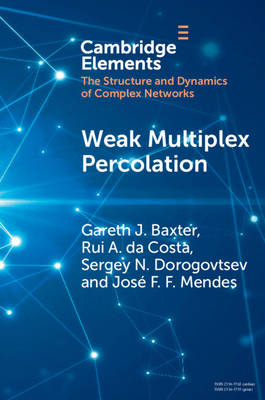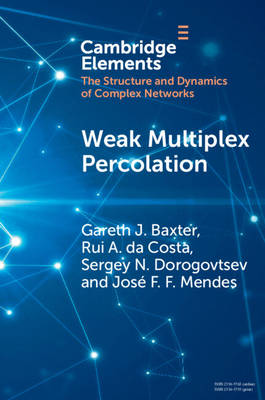
- Afhalen na 1 uur in een winkel met voorraad
- Gratis thuislevering in België vanaf € 30
- Ruim aanbod met 7 miljoen producten
- Afhalen na 1 uur in een winkel met voorraad
- Gratis thuislevering in België vanaf € 30
- Ruim aanbod met 7 miljoen producten
Zoeken
€ 31,95
+ 63 punten
Omschrijving
In many systems consisting of interacting subsystems, the complex interactions between elements can be represented using multilayer networks. However percolation, key to understanding connectivity and robustness, is not trivially generalised to multiple layers. This Element describes a generalisation of percolation to multilayer networks: weak multiplex percolation. A node belongs to a connected component if at least one of its neighbours in each layer is in this component. The authors fully describe the critical phenomena of this process. In two layers with finite second moments of the degree distributions the authors observe an unusual continuous transition with quadratic growth above the threshold. When the second moments diverge, the singularity is determined by the asymptotics of the degree distributions, creating a rich set of critical behaviours. In three or more layers the authors find a discontinuous hybrid transition which persists even in highly heterogeneous degree distributions, becoming continuous only when the powerlaw exponent reaches $1+1/(M-1)$ for $M$ layers.
Specificaties
Betrokkenen
- Auteur(s):
- Uitgeverij:
Inhoud
- Aantal bladzijden:
- 75
- Taal:
- Engels
- Reeks:
Eigenschappen
- Productcode (EAN):
- 9781108791076
- Verschijningsdatum:
- 27/01/2022
- Uitvoering:
- Paperback
- Formaat:
- Trade paperback (VS)
- Afmetingen:
- 152 mm x 229 mm
- Gewicht:
- 81 g

Alleen bij Standaard Boekhandel
+ 63 punten op je klantenkaart van Standaard Boekhandel
Beoordelingen
We publiceren alleen reviews die voldoen aan de voorwaarden voor reviews. Bekijk onze voorwaarden voor reviews.











